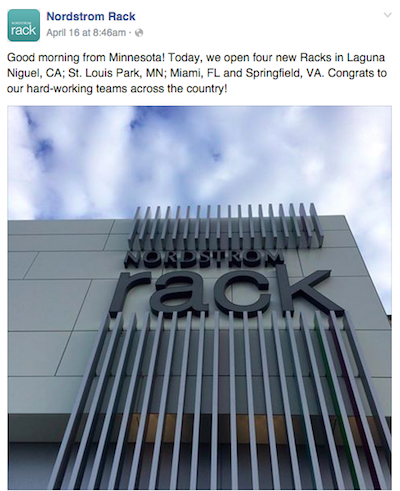Consumers should expect a reduction in holiday promotions from retailers, according to a new report by Upstream Commerce.
Based on the past two years of holiday promotions, the report predicts that 2015 will see a decrease in both the number of products discounted and in the discount rate. Fewer sales incentives and lower discounts could indicate a new strategy based on the “right” offering rather than simply presenting more promotions.
"We believe it's a 'race to the bottom', i.e. retailers are looking at what others are doing, and do not feel they can raise prices back up when the others do not," said Amos Peleg, CEO and co-founder of Upstream Commerce. "While retailers succeed at selecting better products for promotions, as we show, they still are challenged with controlling timing and duration of promotions, as they feel the market is dictating these."
“Holiday Promotions Strategy Report” looks at the average discount rate, percentage of discounted products and what happens to the merchandise after the end of the holiday season in January.
Deep discount
Upstream Commerce analyzed 133,340 women’s apparel products from 2013 and 165,133 from 2014 that were discounted by Saks Fifth Avenue, Neiman Marcus, Bloomingdale’s, Amazon, Shopbop, Zappos and Macy’s. Discount percentage measured the average price between Black Friday and New Year’s Eve against the price of the product before the holiday season.

Saks 2013 holiday boxes
On the whole, the number of discounted products offered and the size of the discount decreased from 2013 to 2014. This is attributed to a change in promotional strategy by the retailer’s one year to the next.
Neiman Marcus was an exception to the rule, discounting more products and at a higher rate in 2014 than the previous year. Should Neiman Marcus continue the strategy this year, it could provide short-term gains, particularly with aspirational consumers, but at the risk of hurting the brand image in the long-term.

Neiman Marcus Christmas Book 2015
In addition, products tended to retain discounts in January rather than reverting to pre-holiday prices, although this tendency was slightly less noticeable in 2014. In 2013, slightly more than 18 percent of products had their discount removed compared to around 22 percent in 2014, although this change is largely attributable to Shopbop, whose numbers skyrocketed from a few percentage points to almost half being returned to standard retail price.
Although two years of data is limited – either year could be an anomaly in a different trend – Upstream Commerce’s discussions with fashion retailers indicate that this is likely a conscious effort by retailers. As more retailers, including other major sellers not included in the study, open more discount stores such as Saks Off 5th or Nordstrom Rack, there is an effort to confine or concentrate price reductions to these stores.

Nordstrom Rack discount store
Limiting discounts opens up competitors to stealing away all but the most loyal consumers. To maintain buzz and traffic during the holiday season, luxury brands could resort to promotions based around rewards points that offer the same incentive as discounting but without penalizing the image in the long-term, which price reductions could do.
Interestingly, the luxury retailers kept more products discounted in January than the other retailers in the study. In addition, the amount of merchandise discontinued after the holidays were lowest for luxury retailers.

Saks holiday gift catalog 2015
Although the simple explanation is that there was an excess inventory in 2014, the report notes that retailers are very carefully managing inventory and that it instead indicates a change in strategy that will likely continue this year. While the number of promotions and the depth of the price reduction may decrease, products will be flagged for discount for reasons other than being close to the end of their lives.
Shopping spree
Promotional practices aside, luxury retailers can rest easy when they look at holiday shopping forecasts.
Affluent households in the United States will purchase $33 billion worth of goods this holiday season, a 4 percent increase from the year-ago, according to American Affluence Research Center’s 27th annual Millionaire Monitor.
Of that $33 billion, $5.6 billion will be in gift cards, the most popular gift of the season. Gift cards enable the receiver to make purchases that he or she will definitely enjoy, thereby eliminating the awkwardness of unwanted or ill-fitting gifts, but they also represent an opportunity for brands to earn extra revenue on cards that are not fully redeemed (see story).
Beyond product discounting, it is especially important that brands reach consumers in new places this year.
A new survey reveals the sophistication of mobile shoppers, who are not simply planning to research products via their devices during the upcoming holiday season, but also to engage in an array of activities, from creating shopping lists to checking product inventory.
It should not be a surprise that the 2015 GPShopper/comScore Holiday Mobile Shopping survey found 54 percent of mobile shoppers plan to research products from their phone this holiday season. However, some may be surprised to learn that 35 percent plan to create shopping lists and 24 percent plan to check product inventory from their phones (see story).
The market often dictates what retailers will do, even leading luxury retailers to discount merchandise.
"We keep hearing that these retailers feel the entire environment is becoming 'more promotional,'" Mr. Peleg said. "Therefore what we see is high-end retailers following market trends.
"We know that some luxury retailers are actually looking for ways to limit promotions," he said. "However, there are other factors they have to consider; they are selling merchandise of national brands (together with their private brands). These brands are negotiating promotions with their entire channels, including very promotional retailers such as Macy's.
"The outcome is a promotions schedule and plan that has to serve the needs of multiple types of retailers - the more promotional ones, as well as the higher end retailers. This obliges the higher end retailers to play the game, or be left behind."
Final Take
Forrest Cardamenis, editorial assistant on Luxury Daily, New York
{"ct":"WjmXUF43lJ+rR5GuVEignNhFW5T7q3+\/H3L7i5NRh8SnxMvY6mH8+DVryGASlHltin08BEU1VXvc3cdRhgTAVG+V7Kw2MFaWNuuH826WMXOpm9ef5g60xis7gij7HkgB6Zk\/RNj6FNT50z5+mlLDFboe\/kzSRLDgS+crkytrHe8LGvlk03l3lH+iwVFdPWrM9GyeIWHZSTp5HVk6NVWIcA908aSm8m+Y\/PGUFRZNnZWMViT7JPyILKXPXFiy6Xma84FuU5YFwJrEtNGtgF+tMVBZ4+Hb3uHruTA7GAj7bAX1EEnjAYXf4JtUhUzN0gPG6J0fGErKM\/sUCeoHOjKnvDO2ah6CyGeSbF\/Ye0Z2m1kg4Y3a6SaVjq2VZZ9T9GuOdzq+gUzdlBULN60ABZWyR0\/6cUf\/p1evCAZR47sKDrJB4jRleLc9CaC66TQYlMmEx4yDerpKmX+vq2DBicT1CEvFDS3R8XEj7occ11GQUQWOds7nib48R42Qd7iJoR8Lsw0SYcpLFGoYz0iIg\/8yIgHsC3cGclGwmuCvWyIc3jJLBH057S+Z9EWqr+O9VD0UmDayvvHvguafxs4u00wkBF7zV+8eaAkwJG5peOqqYCAjC40BDmUSi02HNTdj2X2TKvJumsO2lp58B88WxEyU9pGpoD9qsEnqob2weLPgGafA6vccOK7pMXxdx+yZMKZMnNEE0iCW8v5SnGM868ReECxXRnbJZwAOfwqcPjz5\/l0xblfdB7R\/B77a2K9k3PhtXfu+Rd1byxHDMG1L83lgvUb6LmWtN9S5hT0ex+UE1hD+ATDP4++8wSVDountTwFTrNR+LHCspU8lu450ESOVJHSoSQ4pIJMLYa\/WUfHGsSqcRzmpB1XX5gLL42jqZzviKI\/cUfigWGcU9dlwSfQUP5g4ZbuSqdhyA3LNgqHG72\/sMhXGvU3VMfTOv0djBql+\/llQLMNzzvUm3JHq2hrXb7M06hPoB8TODjSNr0JtpMw0OKVrfudqK\/VObMGMo\/\/YJUFqE8XatsyhwEFk37qPim5IGx8QTCdR2MbQbWjfZmLcSsC+7UsyMnLjmDJeH0i7hkEU2tQ5lJNCRfVNljUE3WfmJlmHAEHAhz1xUzFKQr59kmRxtPJQpTIEw3d4JIKhnODr1px0TDwGjVPyvswqFNhf9ziGwniLGdWSVPxwsYUdOlWjf5of5c4m3FYeyxgm2LxCHqhT+2c3KZqPmo1WIXvLnxAQD4k6KI\/dUbO59\/fTbIcx6bl2y\/DFpUeo1Mf5PDZzQyddHxArvJPnhVFEVhzHEU0QV8y4vyYWEVuwjylEKt6EvssKNyg1AJE8XxJUHLgpjSJQfOZERsyIzc864UicJyY+sZVGsRf8\/i5iub7E6JbKRlmMJnujmS2Vvs3px7kQcMEKF4KTZmPtdDpsXPQ82qEn1D\/kSV6Ue+AKaXdvwohH5tZ8BdJ\/sZiNEBydKAOZchaaiaLGyFKLUz1M9T1\/UjnkuofriD+Ic5bTTqmPfqxkArzgv+0KPH8BZsXxrwVPU60RmyQZxflTrUPjsTtd7OeMjaxYIaoCqyZVe3P8QRpGqiqKxqkI36iEGGbsGOaaLo+wqjMwzuucKlVPu4v9KK7lQKyVczX2x3MTj6VEoIGrO+DjGOPMcAuPgicHJRwps1kTWXhVUpIVa5ZqrUxTgUk2cnTpzu1vRfi340R3ZMFM6QiUE+hGjyn6niH\/Q\/UrH4dLb4q3sgpnMpAX\/shRbziKX+8v6oBTmPKex71bRWilp5Vj3yzc\/\/IOHepq1hIn7f4OwSwsoWxo+8djkeRF6mnnWaCC3q0i6kSPKI2VGXqBPyJQrwosKmNjaLrigZBw5afXlYlhXRAxGTW2RsJp0nFUkBJ5oe6JonKXbBlSLTiQIt6lyEwfLaeV98NWHvaFOxLH04MBGLlMvd8jYqthvrrp9eQf1o8Qi2KyGCo5y\/XIs\/5hY2BqHfN0kI4NqWZIckDax5xRNJBb5hQkFhevJXfhNnquns9xxJeVxaY+PNhxCWNNdoX5duWcFI5Zr\/kxxTWVREkYh2+46KCu\/ebhJsfKSB5FBijt8lcIFK2BA54aY4IkiIrTQAWfm19ZtpE4PbnVHkLwNC9wza5pls39XtiFW6V+EFYASIrdUmJyK1j0RTDm3G0S7ceiIXVFZIGE5Iq\/9F5Jhj0IGnvjOccgsiYdgVuLN7Ul4\/dzIC7rUR2YABIRmxPHFVc6NTHNm0xvcxIRWtvgjenmMV6aXHgyXu7cc1j\/f3aRJ7zjHJKCMRAuS4v2dvQEMW7uBhoJmaSgnt01iafyYlkly0Jo0+GwdSl1sBYkAZNLlFxR7yzzrrPlI25sxoBw4QOsjQ\/gD+41ZsSsyuT8V4FeRXG9SFbsu4vSu+SosCPeM0gFsyCnZ0\/xA7ev+g5tdM0sMbQgJbdM\/ZZBkjHCqwiEqwEOCeT2Pyj+x8eiYCjKgkyBXyFo5PfsGJEBjkXZdUjk62eqXhOeLpKsg\/pMHh9Oac4KgsUAJNN6PQMp1cro06DcRlv27wpRtvJq6CCoxASyoeQYq0FBP0GM2SYiyL9W49xeJw+vwmfaBxmDDi6\/9k6R+UaWirlF2Sk1XLnLZiblkumLR45vW17ChLhlRv+mMRHk19uypVPjek6+ZZr0KhEcvrudzh+IzSU7uwOyGzijoZOOMfgl0Fzfp7f1dblBBGy9bRPxmLRoz3Kmq8rBcbLE2HoHHj+tosXjznHyCt39sE2NqrTBgoq3mXnBZPtFKvRqjZG5QKOYwekKDiR9+iTkrLgLWouXUqbYIoMPRdkM1WQA0dFtE6ylFofbOKyvB4O3K+rI6GkplK6ltOvx5ir7KcbcBB1WSVpbImByaEnyP8YpJpXA8iQ0Vfq\/d5\/s3ugYP7wGT2ERgT9EqnUVesag5M16XY63IMhbk9HyiUHoEHN4pyyRwdWA3849wPSDP67y13E+LoCgvTWI2t5eJ3xUs3DVo\/gcu2WdWw\/WT9rDhYMAbR+zyuxy1W9giM9RhnsofG5W6v1d2rRzXSEpa\/T3yltJNDDsIKlUzDTeu9z1BftHrYQOerP1B+XMR7ooDVxTpGiOPqWxZZcvpIvHSTpQCc4zU3Qy7I5Rwf1UNnLyFmQV1rI9wq0O+rfbCFZ6JckudNpS+rh\/Rcyy\/Bdsz+c2h2afwW\/nXWC2nheWSQVhMsjpD7tEPsSfBfw1zOhiEl+ivqWj6gdnl0ietlboQgdfNeX96zybTKThqAkYqJaE97xtBFOKAKivmxhmDhGIdwvBgyyQo0eNuwD4UMAeWXAXMkiMGMedZuFCjDZTA+bYz4B\/vSCuUdjX1tuT57xPxuk8BlGn8ObymzngpHdBrFooE\/s2KEYEs7a1atUicQnnauVClFclwYdXGQYfS3RKVJqc3OXm4JwoaRdnpXna2oTs8K7Gjiian1fpi6uBVuupMd6yRV\/WvpW5Jlf681EQt\/p3\/GnUeavhahZLtOiUs9GDe5Di1PLVtYQ0aJ+guhZNde3ROYDowTO5WX1axNulKPz7ArDg83MbWGrnza+7LffKG0\/Ayw9zMPwx6IwA2otlro+wWfAnrvj4XKHGZNZLA1bUH5ExVgJ\/kDpFosxUev8XDKl5ImquAO57JMI39DyqDfdr6PXjk\/Or3LP0bHEGzHbtzAjJie1zxf5CJ2iAYgrpzVUHBapx84hLoicIRTblW5DBcF00nZVnKAYyy0NTIHvXBg0pwLl+WBH1eZx0UpoZlf\/tX0HJvE82oCZ3nDszPY8iY4r+7iSBq1bTSimy4vdkH1HArP8fJCb3CbZhOUEgwzwEQmMSOjZcpf1JzCjDCGIixz1NiLXoLb3m3c4xzISkmWXtMWVy06J01Oju\/V9c3cYM5QhWWuQIBU3ulfO6zhV64jSkpfbpRoStP0LNIhrN1+bOcgJEVXGekvV3ntfD635xTTggT\/Y\/mmu8nwMGVGt59FMTg564Esg\/3sfqGKni2+0sYh+FXoA4tNA4xUz58SRpgAho\/BBe498io8AMPoCu0R92Dig1eFtUwgcIT45Ngl6miGvBb77CreVVccvNlspgvu+5mOkwRJZWrV\/hTVBModl1EQPW1x4fvmtIVrkLiLAwC2djLkPAD7nRNxQolcIdIFQ6VmY7M8u9W1jYnTkq6Ijgj33mo39abUyW\/ejXSw75WRhLa4xiBXivWAv8S+rhYIv44opRyft+VKcFZg7MlQlN3c1ArVuHgvnyePS8JRFZ3HPHkjcVgrNhVSV3VuDQf92\/ZZ9SdljE\/+eNVDchOum5\/FJvecix0ko2PA792D1XLS6ZZIZ24fznZvhmcaIuGyaG42iEshIaVS4xFWnoH0TXhdqwJFcg5H2l1Iw4XyTKlWgi6N86OfE7ZzkJ\/yGnYDPluecXxJhlbVeFLiDC2iwoQYxJO44Wvj3xOUHm0ee36gpZnDfC5Bdkf3CUQ\/gdSPRxBza+bag5fdUYTwrEwx\/pB4v16laJReB\/fuXDXhtrNDIjQ5yCrwIPgAdjAYy6vsDUBiGQ069S7ssZyb3Y58Z7od48P693c\/JzJMWzFZbzNJO8XkmKHsVCK4bwYoaXg19K74FJMxDzo4wtvs8x0HwLD3TTMcJQNz1yaKe9R1Z52rfvLlm\/a39tXnWx1fWPkh5oCrn9JA7jPOc5fxGdekDZkz2zH4UYdtVaFwuseyJ5uzn7rvBJ3OjjNWtoa379fKnvNqYbpyGfDdXeKqEPfj4tnsg+V9m8SQbCttEh9BEWyy0W6\/jFSe18AQIOcsu\/N\/DLccPE07f4ikiXHHNPrKwTeMmdYS2765mvU\/816j+cpZ9QFAEYfu78h6K36OJO9vxaba8gcvu47\/utCFpzpk3N0DYs7XxmUtgnDYhnMdpDI9sF7BKREO3ttry2O9SoaZRrEM1478i3tw1KeLWkYAdZT3AePqmtajblg7k50NQvUZY7SymB8ajMAZbPm6ALR9sfHvsnjeo+1lrY1TCkOKQYEk\/0chlMnuWnKimye8t8y6UGCrhZDpsvFbrWgui9jDB\/Qb2KgmOD4L3SwBkGD6ebuXDOCHpNJxQoM3DwgDJiMZ1oo1xbJpdcOCG8kY97ETonDbGM\/QSiRxdh\/3JQQVz4LD9QLq9WLfEONvrapBCCv1TZ2UskWStddQm21dgrI0CYQn4uhYrpNwFSGmnTjI5oLYZizqiX7\/xWUOMTcSOQywZ4lb027EdpuFowEhSebWCYuGQ\/EETJV2Wc5+q8SiqFJC5kGqpKrrs5XZPSaxxSMGDdQ0b2ArtMPP9ycf6O7IjZwQAqbQqhXCKq3lPDxA7Ex\/jIgL5rXtMEe4KWzxI8rgfKTTJ0acE0J1EYDWyi7xnoPYlT8LTwYdqtWJn5fqpx2\/t110Vovy6MW0El\/OG3QuXy9gVEYSMAqvv7uoOzfIq+gsHKSby7tU7EhFdzphmO+uAawO2PwD6dkDjDlzevbWyFj1XDAUw2k9YlLlFqibSA\/5MzdQ4dTacRVrl1DtSXzS8iqlBtf1UU5QYXszKaT47kK1slMu\/+56MzhAaDx8ZCyty3JrVY5dQjhs3+1BMrmr2j8tpDhvqE2cZEEUUcHzUHrhB+MRhQEaRKwuNxveRqBeE7rY7V5dEl9TFwrbBpsMjmmAOyrYnHqi69nB69+d6XvwGL9E2o3fSa+Xpie\/EO1zeIE52Y1xRt0QcwYpyskyiFz854jjT2nx2whS7IsglMdcJN1J8Eq1dVCmYVrfNUN4n+i81jpblzjPHl2vKe3up1GxMhRBpiwty3yqIZIYB6PcBby5SjxK6yWqlsf93zBdWjcGtF8DahkFyJNpfFuX5HN9X+jzzde2PKR7JgKKqEujj+c1ey182N6fiVkUYy3geqrW\/8bGEsLNix3tNgcy214P6nM2FI3cFdPX0ercnPbWy9KZFo5JnpiXsX1sUuAqtpk0TxYSC8UXtabBEJggtndeIuUdJ7B6\/kptvOjveDmpSdvbcHipRNQItZWMoTE6nUABpyg28VJX8VI9SJm38Y\/Ub6\/1G5JMMg884D35nterXZjHlpwUKh8g4MtAvB727h8HfguttUFYe1EPUkeinvK28adLHg3XqoEswxuG2uzBUvsAl9BxQx7To7VsMVR4ztTnP5USEmktbgS70uQtZku7yobMKWgTQiOswvkkO31rWskS+58C5wgDfqraONRyzn1cp63AOhdERdoLnfbIgvBH8p14ggFKqM2uNm5O6GVk3631Kw2FKG5sj\/+OD9dRnsFU1ov3xkfGfGz7XTRKOQGj4JwiQ8+78ZdTrsClKgZJHJEpNTtN7wwVxtrwLnU5mWyiOACp\/KVgln6jkqcrJt\/17Bz01YXOfDwxyajnEZiHE2\/csfpAXy\/F1tfUw3pDvmY3vZDTr+1ZNxqszJtNkmYtE0eFuEEbDtjGOZum0SkNE4oEznxeLCjBl2BtsfaSydCYfrin1cybdD0WS\/i10jpqJ4P2bN3m9M2z0qXhCXz3ilcq5IIObqWjw5lUljo8keMy2rFYfDImH\/h46vCtzxu93C8lIsegpT++caDgsR29MyjbRhfSkbuaZlBsHg1RYquXf57U0baIdZGgBGxMaCBDolhYqou4UAL3PuxFongs2Go\/xK2HHVQa+fykIH+F6v3PhAf1fuCT4dS9jqP8OFjCnOb8Ff2QcCRlMxSz2yWkPHSL05PcmMBRFUkcJ1QvHeMFolsILKNlUT3K8+9yau8qfO80ef1fVs\/1u8fP5DRoFxhXRRTkQ8Uk54cMS1nEHq5h42yYRy8xBauO8VHxCGSV9gLzYSvA5Zc9NY6GS7bLInAfxQX8nueQvr61YRwH74yJEaqgJycbgB7fcxYWNVwD1ukQ3w5LOVD2ttbWtrNdKqU6bNr8V4nkTy+tjxlttSap\/q93Mj3JqGAPdSZ849L6i\/jo3aU8Vkr\/ixlmcjT1kkMUcYu6zliRfrUM51g+ESIUTDM4kdE12g\/1lE1bLB3TiNayxT4jtkL2QnPDiOI7Vt71ijDmyJmlqq4wzoQPURaakbim4XwlugNp5BnsFxphA84AiOMcWhKRZco+Y9kmUX09SIotXJDVMwQxo13PmXNsCIn287DxFlD\/8\/b5Cp8BLIdEbTc8XoIeaLxujBPGU8xUrNx+BV4X\/SJPQTKp1HABJlZz5yK3BTjuSCz+pGoyoe+Mv3Msao5YqvfgqfQVo+oFxSnIolhWjBI5TIzMVsxHRNFd3SZ6nYl0IxMmxf1gjH70fB+rsS4Z1OngxGBEHY+JCXYg23kGkBdPAYJqbtcfwbW5kfko\/YAWtMGLcohyepwtKEf6wk7mxNLg9NDcQXFe1Wc\/8Fe8Xh4avHBOjvQD3s\/vglN7Dci2jz9l5Gj1vuLZ0FGfo5mKV36TVRujqMP\/clwagAG1eEYt9\/Kea64M99ORqabnXX97Uq1Cab\/93bN8ywSMU96a3A852dmpA6jgQPHXt8cLtbRx57jnBEYMQJFeI4SekjXrK9Y7996U27OeKWQqz\/nV5beMuMiFVJ+u82oCpU2tp2DY6IDZgGChqPanlgLy\/zyWkJ7uZ9xh1RgarNnxHXEGEvf0KaoHdR5KzexgVRx7x9QhxcNYJGVJBgS\/oSXgKPNWfgL3ht83kJF5+6zNYQpKR3Mk2TT+r2soMg6EzlV3qyqk7adUM8Yv4FkjuKI1hjeNIjXnjdzFoyptEO65lk\/mkjWyexEhJUfukVREHMzZ7qP7fnoVZTo5xE338wXXiWLPn8TNWEiaqPvazXzjUSrR6OgWuVXtyXxwggI7Fpmy7qcVaWBNaHw1+GisfW+0DiIBWtEM\/XzPMAnq0CFwEf7v2CyK\/JXrEFOjSsivRYvFKj\/Le7ScmcSzzXLzucDlT6\/RB9a0dFxuKzu2HgQN7+C+IvujZgz\/YL+TY6z01n4D\/FirHWKLmZZzLIuR8YsNv7HsgMdL3IduOqTpg1wJZOpT6hiK6VwkAsA4PTmb5SrTPji6Ru9kdhI7WqSr1jWHx7S4Dm1hKgqRw8lRxYu\/t\/OwNmmPjsIuRCdGztJVReflp1ax475p5E\/yryI2uDoS9\/4wlrSb18IEpOqoyMpTPEZ6GZ4MLk6hsGMJH8vBlglM+zAg5kcmGHgqm9Mv4Jl3\/JJBCoA4Z8HP0CAVttoq1sBG9Y8wd1QR\/t3oZkEKzS\/zWIqgE41jVHzfoP3T8R048usZva1smRksgQY+Dzs07gJtKvkfZwyzo++vgMUWK0c0P2QDGcB8+tm2+Ww5Jv8JT99Hx4Kp6q+UwDCcs\/qYR6Fc5hCiBiH\/lfRWxuB7ooJ16guOXH5rzkE92hJA9+viET1ZGaHcMaFIfcNZQnrPWuGh265v0+Cx\/VukQYWIV5\/5tBnWDzaNCctK9IQvRxNVvnqDmNxB8Lvf19LhYa1UdOuWRBWZclrCH0TqYNDao8JmWVICJG8ITLg9rvRqsjHXZHOTqZcLd1GUkiUAUBOHToBpraubZ1wJqsZveJMwjHc+89+aYmqiHezoEpwCjsfrM2HnkxRrj5OUu+rsv3schYj4eD6QeDx0PB+fUNxoDX+8fpdiC7T3e+4\/pGM1i\/pmTBFsjw6pktx5OgQxt2es8+jOSvOm5gmGLDIe0TGeTlY4lIS7D0KYLtpMfsn50ywi2qd0SGCs0xHn\/Gu27c+1GSPr4AJJo1kX+7eUTWa1WP3PZ\/72ksA+Pn2513\/4COI3Ob5FYy6LynwKPl1drEl\/SR5KDg9b0B5xfUI\/v+pTrnbPk8YgR4dqHCwHyJDGIzVxmjtwwX2QQ3FGbzvXmRJoV\/Az4BDbVr33R47KxFiVy1Sjk0JP1Rr+ZhFMcCVdcdrsuiA5a1qmULmDYtpjiw+AtC+6ChvaQUnHWCKyYf\/wa2RrXOvTMx+K5G3seQIvvNDAqPXT3NFBAihvWcSoCNnr8i760Z3n71q5eKiaJKYyDSwVX2n9fBXa1+KC2Y++BqhjbBwtHWB44TPZ9mOlujQ9elDrJxP7kNlN7z2\/wM366WqIbr7i0iGN7pRLnJCdfFeI6okcEXljYmDWF0ODChOkW8Kq1fTEQimUB+2YKhmhODPYxjNMag1bjwoGI4Th+kYNKq3wC2aB5TW0Jgp0cZEDdLCwr2JkoBueG0dn9HxGkA1Ds2j\/EPdVXI\/D7zo58NfJ83CBGlkOnNRX5dhM4nO+7k45hWZcHtba8IwzO1XXfiS7gOuoXtX3Xr7VCC7wrMzIVIAZByhmbfAjO5rFUYfqliCVC70W+GtGOU4qvG6mz10sYcbzt8StmjgbOo2+Exk61Y1Hjrf7yQNQbZbMfCf9BL16djJBS\/fXRs2tlOI7MjbhelNFAEOKIz6sFvmhRE+CrQJaGUMYGAUYfW4NwK8KiE4YmttRucUe8ZysU6ixu8\/x720c+qImN+NRnnN1rdhlQaNKegOfk+u1FGflYl8f40bAsdhf9kZ6ZTNX2cBVGBtsg6hGeGe1c5CukfTFlsHUmjg8k5Yqij9fPJZE+r1+0j3o98mt9qp+adM1hewvjHtiL4Zd3lV9U6fT2Xialn\/MxLBCxWPsI08OUmryHiIMRZ\/PoiMXFNJ1w4rX\/9sd8KaXetnWddFWfrj3mTX2zTAubI29enoN3zfGjsKqTpSJqjMM2FDE+n+o1PjZjNZx5\/WgZ49GtOAmCC5I+dPtwroQujwTMjY9TxEYVGWf5AWG2fONG29bV3zUSCcj0TifZ4aHwf91aB\/acL7kIICR7WN0fDhixeemW1hFIloocaEzceXyj1moEH8+qF3UyatUc7SURm0gV75kqcShl8lJWbLASg0zuWoSP2VzalolKpQVIzGQ7\/pL7XGPvmT9C\/jl3cwwELEk83wY0Eo+xO8XQAI3MsnqkBwC\/YnqTcbCxrTufctETowYj3bFcXiK6XaAJbIvq+obIQeAexJVD5FHZe239SQEeAaeYYjtlzeOgpu4QFRcCoHx2YXcd0bax1F+5fZPiqDm7Im6D7TQtM6fRtiBqXPL9ZYQkMv838xEbGW5Kzt17Gek03Wkr928QCUTyKfTSRW7ONDLzddHXC2bfYi1sw0Dq0IUlHbDOAS7jwBdrtMNx2rn08BCytTxDFn2YMmEgAWhSXQM4m9tdSec+wD46iHveC8QByJbbSn5\/FV1XDC+TAxw1aF5jYXZATs47uXtDLWPaGwHwqeZQJVnCHpQ9n1480Y4ctOkbrIFfAqP+uIajoiAx3TjFs47RNEeFEstuD79lyHMcXpfmDj3d5QpnGxSrRNDdBXZSXbnOGns5CtPYBsxA9YvaNHvjWNEjR3k\/BHRFLZmL9gd\/BvN7lviqGrCJBhCScGLQykOsN1ecL3R\/JJO4N0\/Lf5+0RW3a4jEpU0thRJpnbY9Tay5Fin3+hpGAmlkqnkXZzjRlTQQyWFdvIC\/bTPMzZlhTuC95hlUoWF8Hv6fR4NqWakmZF6BIRK6nrFg7CrxUdBBycVSqxQrJQMObRkbncWNwjeUjog9doYp7Wkdqr\/3T2UXTTiHnnniMxuYDJvtI0hdOQeEnMNKiRn5+2UeZBGTTwqie2lQmBwkBljV8udZCm4rSB0LbeGucJLtKuqvq8RoljDk2VqyugpG8Xy10c5tvNE7NXGdeXH5w4MoyISYaGaA5O8rj0K0XL6w+QVFHNXcoPapvcGxtivP2dH22OpcZfWO5ddwbgds9KR8CcFU0UJm6taBqKmuiTgJQu59fzTt+Snk803F4PxoDnjY3uLWjgLqvxq2prAWUPNp3eeVurOyYia3KqUUg9sWghi4kFh6XFJbTogUkX85kRxjuQtAkppKPVqC0mYBFy4ox24fp8bbdSmoGAoQMSha711nOjCLAD5GGHDTx7ims5blYJPzd44RWxf6qZhNOkAdC547VwfE7IS7PoOP7gYC1CMzaINiPcYiJ0\/hbeEGjYWuRkyPBklDYSCo5OlOgPEwK5nBhiqS\/pDsk4k5pWvBfGKRblWeU+vKUDTbQ0GhoELPzMC7Zfw4romgdfeejNHrbiKq0TEHcPwKInV\/upwGh\/Bu2l4V5QChXqrTE6h38OUpA1rcot2oPoDNZcYpqFep4IaI3Oj3FgBhYOjkvNd37\/Bf43H+LEXtvMAszFtH5+EvdzkDpDYzCjkQ3SMydE\/jzdOLMBn1b7PBJuueT8uL3F\/qTiFV2Z36+Mmt2INcT4XtJfXo2zFUNzPFVBRbgRlDOlHUjBfoqZWfnHidDnDCRGQ1mBfuLRxRwwKfb6CZlESEZmJ+wBMjZyuciEG5Gg9jLM70wHsE3cNRBQjTA2E9VYLfnQ\/Cu7SaRWgdsnwDAhMLMCplw4HyAn7bQOaHz38FgeI+MesX13UB7Jr5nmtbZ7MA8Ikuo1g8KMWWZewkMaXRZvzeRWDHIMVNz\/nCg29me\/EgUotk1Xj\/+4cITyKOtFWnxYknnavrIFxMPRJ7w8gkb4X3Yer\/yfpspJxDtzSeZKNZIX2EUHd3lNzoRAz3n9DqQNCvnynYukSJtc92Jd5\/kk+t8XFiy2O2gTjvU0G3HZsqjyv2BkNBJwfppUhn1ASDBFQ0wHaqkZdNVrZPsjULfc\/bKDaP3Tj8VCW+\/EPyZpgg4M+4JCrzb6Njh4\/ATdxjgcy4PacVm9E4Tq9wfV8Y7GNu56h1zP9zlomb6YkXgIYVok0KfANdxmrnioGReUahp9tsAfm+EuUcDzsp4MYFjmsDtm02LOqYQJvENNUgsz\/0xRK4h6Ox+L75lAOCnhUPzdOTvZIkWvK0SglJ5q71CWip4bFd6ihAQ6uFh69FGLRuzn3oxM4SW+ZsF9dvcCB9XWrsKl9fiOa3zgs8WmbHEjcxAjpvDdST8odwuwDJFnzDxcC7SDgcvfPgTAtE9rNy0QVL1849T5KXiNZpHv9eXwZaZGQCsOT0v+NMgCTqlbQK2j2\/vlgOfN5l0jkdp79AcqWH0j7z0vMM4NzbAe4bAMD2FnwF9HPJ3hHTJcpLjI8k\/aI\/jCnTiZ","iv":"5292ba1332b40f94c8d50fd70c884d8b","s":"cc0751a05ad7cce0"}

 Image courtesy of Bloomingdale's
Image courtesy of Bloomingdale's